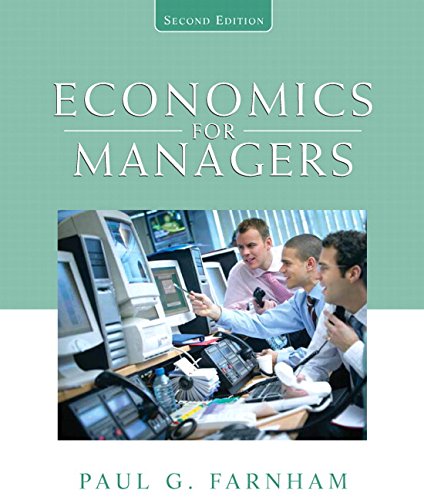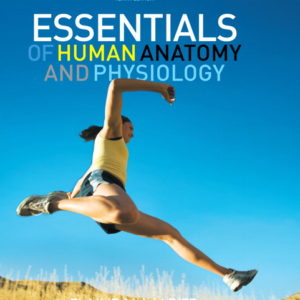Economics For Managers 2nd Edition Farnham Test Bank
$35
Description
Economics For Managers 2nd Edition Farnham Test Bank
Test Bank for Economics for Managers 2nd Edition
Which of the following statements is correct?
1. A) By and large, managerial decisions are not affected by either
microeconomic or macroeconomic forces.
2. B) Managerial decisions are affected primarily by macroeconomic forces.
3. C) Managerial decisions are affected by both microeconomic and
macroeconomic forces.
4. D) Managerial decisions are affected primarily by microeconomic forces.
Walmartʹs decision in 1994 to continue operating stores in specific cities in
Mexico when other firms were pulling out would be best classified as:
1. A) a microeconomic decision.
2. B) a macroeconomic decision.
3. C) both a microeconomic and a macroeconomic decision.
4. D) neither a microeconomic nor a macroeconomic decision.
Which of the following would be considered an example of a
macroeconomic problem?
1. A) Should Microsoft reduce the price of its Windows operating system?
2. B) Should JP Morgan Chase increase the interest rate it charges its credit
card customers?
3. C) Should Mitsubishi eliminate one of its production shifts?
4. D) Should the federal government extend the eligibility period for
unemployment benefits?
Walmartʹs entry into the market in Mexico had the effect of:
1. A) reducing competition and raising the prices of many of the goods it
sells.
2. B) increasing competition and raising the prices of many of the goods it
sells.
3. C) increasing competition and lowering the prices of many of the goods it
sells.
4. D) reducing competition and lowering the prices of many of the goods it
sells.
Which of the following statements is false?
1. A) While managers must understand how output prices are determined,
determination of input prices is irrelevant because it is beyond the
managerʹs control.
2. B) Price determination is the key element in any market system.
3. C) Input prices influence a firmʹs costs of production.
4. D) Output prices influence a firmʹs revenues.
All else constant, the choice of whether to use a labor-intensive production
process or a capital-intensive one is depends on:
1. A) the absolute prices of capital and labor.
2. B) whether the economy is growing or shrinking.
3. C) the relative prices of capital labor.
4. D) the type of market in which the firm operates.
Which of the following is not a characteristic of a perfectly competitive
market?
1. A) Limited information is available to all market participants.
2. B) Ease of entry into the market.
3. C) Outputs of the firms are perfect substitutes for one another.
4. D) Large number of firms in the industry.
Firms are considered to be price searchers, as opposed to price takers, in
all of the following market types except:
1. A) monopoly.
2. B) perfect competition.
3. C) oligopoly.
4. D) monopolistic competition.
Which of the following conditions ensures that excess profits cannot
persist in a perfectly competitive market over the long run?
1. A) Large number of firms in the industry.
2. B) Complete information is available to all market participants.
3. C) Outputs of the firms are perfect substitutes for one another.
4. D) Ease of entry into the market.
Which of the following statements is correct?
1. A) All else constant, a monopoly firm has more market power than a
monopolistically competitive firm.
2. B) The fact that the firms in an oligopoly are mutually interdependent
means that individual firms do not have any market power.
3. C) The amount of market power a firm possesses is unrelated to the type
of market in which it operates.
4. D) So long as a firm is sufficiently large, it will have some amount of
market power, regardless of the type of market in which it operates.
The market structure that is characterized by a small number of large firms
that have some market power is called:
1. A) oligopoly.
2. B) monopoly.
3. C) perfect competition.
4. D) monopolistic competition.
Which of the following market structures is most similar to perfect
competition?
1. A) Monopolistic competition.
2. B) Monopsony.
3. C) Monopoly.
4. D) Oligopoly.
The key characteristic of an oligopolistic market is:
1. A) mutual interdependence among firms in the market.
2. B) production of a homogeneous product.
3. C) the absence of market power by any one firm.
4. D) ease of entry into, and exit out of, the market.
Which of the following statements about monopoly is false?
1. A) Because there is a single firm serving the entire market, the monopolist
can charge whatever price it wants to for its output.
2. B) A single firm serves the market.
3. C) There are usually significant barriers to entry.
4. D) There are no close substitutes for the monopolistʹs output.
The assumed goal of the firms that operate in each of the four market
structures discussed in the text is to maximize:
1. A) profits.
2. B) revenue.
3. C) price.
4. D) sales.
Which of the following statements about the circular flow model is false?
1. A) Households supply resources to the business sector.
2. B) Business firms buy goods and services from the household sector.
3. C) Businesses supply goods and services to the household sector.
4. D) Consumers earn income by selling resources they own to businesses.
Which of the following statements is false? In the circular flow model:
1. A) factor payments are made to business firms.
2. B) consumption expenditures are made by households.
3. C) the funds needed to finance investment spending come from the saving
of households.
4. D) GDP can be measured either by the income received or by the
expenditures made.
Within the circular flow model, which of the following is not represented as
a flow of funds into firms?
1. A) Government purchases.
2. B) Consumption spending.
3. C) Foreign purchases of goods and services.
4. D) Income payments.
The major categories of expenditures in the economy are:
1. A) consumption, gross investment, and government purchases.
2. B) consumption, fixed investment, government purchases, and net
imports.
3. C) consumption, net investment, and net exports.
4. D) consumption, gross investment, government purchases, and net
exports.
Which of the following is not included in gross private domestic investment
spending?
1. A) Business spending on plant and equipment.
2. B) Household spending on residential construction.
3. C) Household spending on durable goods.
4. D) Spending on business inventories.
Assume that with existing tax and spending laws, government spending
exceeds government tax revenues. To cover the resulting shortfall, the
government must:
1. A) Borrow money in the financial markets.
2. B) increase consumersʹ incomes.
3. C) lower interest rates.
4. D) print more money.
Gross Domestic Product (GDP) is defined as the market value of:
1. A) all final consumer goods produced during the year by domestic and
foreign suppliers.
2. B) all final goods and services produced during the year by domestic and
foreign-supplied resources.
3. C) all intermediate goods produced during the year by domestic and
foreign suppliers.
4. D) all goods and services sold during the year by domestic and foreign
producers.
In the equation GDP = C + I + G + F, in which F equals net export spending
(i.e., total spending on exports minus total spending on imports), imports
are subtracted from the other types of expenditures because:
1. A) imports reduce national welfare.
2. B) other countries do not import goods from the U.S.
3. C) the value of imports is difficult to determine due to the fact that they
are frequently stated in terms of foreign currency.
4. D) the value of imports is included in the other components of spending
such as consumption spending.
Assuming that C = $4,500, I = $1,000, G = $1,200, Exports = $450, Imports
= $550, Depreciation = $600, and Indirect Business Taxes = $500 (all in
billions of dollars), GDP equals:
1. A) $6,000 billion.
2. B) $6,600 billion.
3. C) $5,500 billion.
4. D) $6,400 billion.
Which of the following statements is correct?
1. A) Because it is subject to change, and frequently does, consumer and
business confidence has only a minimal impact on future economic
activity.
2. B) Business confidence is extremely important and can have a great
impact on future economic activity. The same is not true of consumer
confidence.
3. C) Consumer and business confidence is extremely important and can
have a great impact on future economic activity.
4. D) Because it has historically remained steady, consumer and business
confidence has only a minimal impact on future economic activity.
The type of policy that involves interest rates and the availability of
loanable funds is known as:
1. A) fiscal policy.
2. B) federal policy.
3. C) strategic financial policy.
4. D) monetary policy.
The type of policy that involves changes in taxes or spending by the
federal government is known as:
1. A) strategic financial policy.
2. B) fiscal policy.
3. C) monetary policy.
4. D) federal policy.
If a countryʹs central bank wants to stimulate spending in the economy, it
should:
1. A) decrease taxes.
2. B) increase the amount of assets banks should keep on reserve at all
times.
3. C) lower interest rates.
4. D) increase government spending.
If a countryʹs national government wants to stimulate spending in the
economy, it should:
1. A) increase taxes and government spending.
2. B) increase taxes and decrease government spending.
3. C) decrease taxes and government spending.
4. D) decrease taxes and increase government spending.
Which of the following would have the greatest positive impact on a
countryʹs domestic economy?
1. A) A decrease in the confidence of foreign investors in the countryʹs
economy.
2. B) An increase in spending by foreigners on the countryʹs exports.
3. C) An increase in spending on imports from other countries.
4. D) A decrease in the incomes of consumers in foreign countries.
Chapter 1
Question 1
Which of the following statements is correct?
Correct Answer: All else constant, a monopoly firm has more market power than a
monopolistically competitive firm.
Question 2
Which of the following statements is false? In the circular flow model:
Correct Answer: factor payments are made to business firms.
Question 3
Which of the following would be considered an example of a macroeconomic problem?
Correct
Answer:
Should the federal government extend the eligibility period for
unemployment benefits?
Question 4
Which of the following is not included in gross private domestic investment spending?
Correct Answer: Household spending on
durable goods.
Question 5
Which of the following is not a characteristic of a perfectly competitive market?
Correct
Answer:
Limited information is available to all market participants.
Question 6
Which of the following statements is correct?
Correct
Answer:
Managerial decisions are affected by both microeconomic and
macroeconomic forces.
Question 7
Which of the following statements about monopoly is false?
Correct
Answer:
Because there is a single firm serving the entire market, the monopolist
can charge whatever price it wants to for its output.
Question 8
The key characteristic of an oligopolistic market is:
Correct Answer: mutual interdependence among firms in the market.
Question 9
Which of the following statements is false?
Correct
Answer:
While managers must understand how output prices are determined,
determination of input prices is irrelevant because it is beyond the
manager’s control.
Question 10
The type of policy that involves interest rates and the availability of loanable funds is
known as:
Correct Answer: monetary policy.
Question 11
If a country’s central bank wants to stimulate spending in the economy, it should:
Correct Answer: lower interest rates.
Question 12
Which of the following would be an illustration of a microeconomic issue affecting U.S.
auto manufacturers?
Correct
Answer:
An introduction of new, more fuel efficient models by Japanese
competitors.
Question 13
Which of the following would have the greatest positive impact on a country’s domestic
economy?
Correct Answer: An increase in spending by foreigners on the country’s exports.
Question 14
If a country’s national government wants to stimulate spending in the economy, it should:
Correct Answer: decrease taxes and increase government spending.
Question 15
Within the circular flow model, which of the following is not represented as a flow of
funds into firms?
Correct Answer: Income payments.
Question 16
Firms are considered to be price searchers, as opposed to price takers, in all of the
following market types except:
Correct Answer: perfect competition.
Question 17
Which of the following statements is correct?
Correct
Answer:
Consumer and business confidence is extremely important and can
have a great impact on future economic activity.
Question 18
The type of policy that involves changes in taxes or spending by the federal government is
known as:
Correct Answer: fiscal policy.
Question 19
Assume that with existing tax and spending laws, government spending exceeds
government tax revenues. To cover the resulting shortfall, the government must:
Correct Answer: Borrow money in the financial markets.
Question 20
All else constant, the choice of whether to use a labor-intensive production process or a
capital-intensive one is depends on:
Correct Answer: the relative prices of capital labor.
Question 21
Which of the following statements about the circular flow model is false?
Correct Answer: Business firms buy goods and services from the household sector.
Question 22
Gross Domestic Product (GDP) is defined as the market value of:
Correct
Answer:
all final goods and services produced within the boundaries of an
economy during the year by domestic and foreign-supplied resources.
Question 23
Which of the following conditions ensures that excess profits cannot persist in a perfectly
competitive market over the long run?
Correct Answer: Ease of entry into the market.
Question 24
Which of the following market structures is most similar to perfect competition?
Correct Answer: Monopolistic competition.
Question 25
The assumed goal of the firms that operate in each of the four market structures discussed
in the text is to maximize:
Correct Answer: profits.
Question 26
A strong Japanese yen:
Correct
Answer:
induced Japanese auto manufacturers to shift their production of cars
to the U.S.
You must be logged in to post a review.




Reviews
There are no reviews yet.